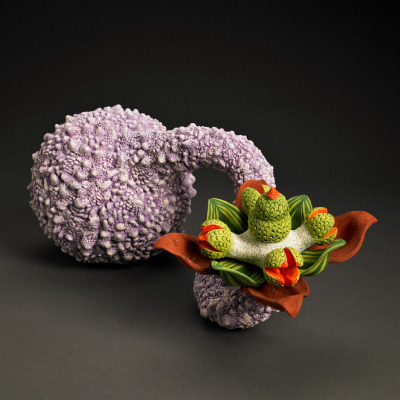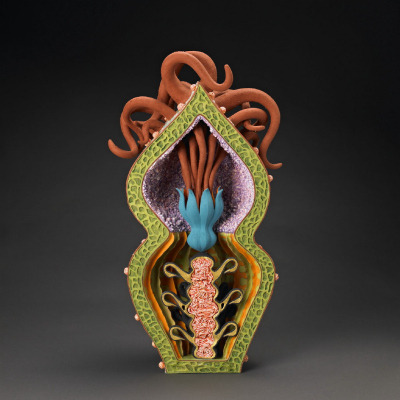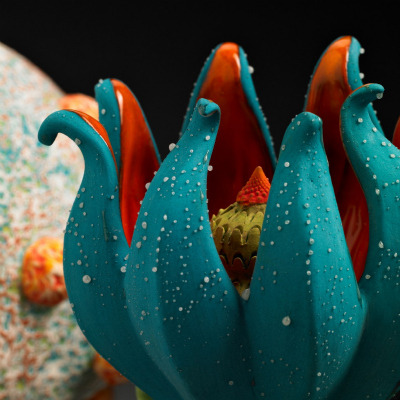
In what techniques do you usually work and what materials do you use?
All my work is made using clay and fired ceramic glazes and materials. I am a bit of a purist about this in my own work. I love ceramic materials and surfaces and do not feel the need to use cold finishes. I enjoy mixing my own glazes and running glaze tests to get the resulting fired surfaces I seek. I love Terracotta clay, the color and the feel of the clay, and that is the primary clay body I use. Color is important to me in my work, and I combine both commercially bought materials, underglazes and glazes and my own studio mixed slips and glazes to get the results I want.
I have two bodies of work that I make.
The first is my ongoing explorations in sculpture and vessel forms. These are one of a kind and always evolving. In this work, I use many different techniques combining hand building, slip casting and wheel throwing to get the forms I want. I make a lot of slip cast molds from found objects, usually objects that I have some kine of emotional response to. I often manipulate the resulting forms making 2nd and 3rd generation molds. I also throw and handbuilt forms and make press molds for future use. That way when I start working on pieces I have an inventory of shapes at my disposal. My visual library.
The second body of work I make is a line of dinnerware and accompanying serving pieces that I produce and sell exclusively out of my studio.
This line consists of dinner plates, salad and dessert plates, shallow bowl, deep bowls, tumblers, and cups and saucers. For the dinnerware, I throw all the original forms and then make slipcast molds and pour the pieces in Terracotta. They are painted by hand with underglazes and fired with a clear glaze. The large bowls and platters are press molded and finished the same way as the other dinnerware. These pieces are my production line, and I do not change the designs very often unlike my sculptural one of a kind work. I make all this myself; I do not have assistants.
Where do you get your inspiration for your pieces and what motivates you to do a good job?
The inspiration for my work comes from several sources. Ceramic vessels, Ornamentalism, plants forms and other natural forms, childhood artifacts
I have always studied historical ceramic vessels ever since my university days. Some of my favorites are Persian Luster ware, Italian Renaissance majolica, Tang Dynasty Terracotta, Japanese Oribe ware, Victorian Majolica, and Noritake Art Deco Lusterware. Color, pattern, and texture are essential components in my work, and I have always been drawn to very ornamental historical pieces, palace pots of all kinds.
Later after university I became very interested in gardening, and this developed into a great passion for me – I became something of a plant collector. This passion for plants also led me to look at close up photography of plants and botanical illustrations as well.
I am also drawn to certain shapes and forms that trigger memories, and I use vintage objects and toys as the source of many of my molded forms.
For example, I use jello molds to make fluted forms for the bottom of my goblets, and I use a toy jack form for the base of a small sculpture.
What motivates me is the continuing need to express myself and desire to explore my ideas. Having deadlines is also a motivating factor and the longer I do this, it is the opportunity to put together a body of work that I can show and share that pushes me forward.
Do you remember your early works, how did it all started?
I took my first ceramics class at the School of Art, University of Manitoba, Canada over 30 years ago. I was taking a painting major but when I took my first clay class in my second year I changed my major to ceramics and never looked back. I always wanted to paint on clay, but it was a long time before I accomplished this to any satisfaction.I gravitated to hand building right away and trying to work with color. I found clay very challenging and it took many years before I was at all satisfied with my results. However, I was also always completely captivated by the material and the process involved in firing.

Portal 1 – Fulfillment – View her works
What form of exhibiting do you like most, what suits you? Tell us about your past exhibitions or residencies.
I like to work towards a solo show every 2 or 3 years so that I can create a body of work. Since I am also producing dinnerware, and teaching 5 classes a week , it is this opportunity to produce a new body of work for a show every few years that keeps my work evolving and me growing as an artist. This is vital to me. I also like to participate in group shows where smaller numbers of pieces are required. I have always shown in galleries, both fine art galleries, and craft galleries. My work takes me a long time to make therefore I never did fairs or shows where I was required to have a lot of pieces or fill a booth. It just was not possible for me with the kind of work I do.
Also very important to me is my work as an educator, and I teach ceramic workshops both in the U.S and Canada and have taught ceramic classes at Art Centers in the Seattle area for over 20 years.

Aurlia Blastula – View her works
Where can we find you and your works in the next future?
I show in Seattle, Washington at the Pacini Lubel Gallery http://pacinilubel.com/ I have a website http://www.carolgouthro.com/ through which I can be reached.
NCECA, the National Conference on Education in the Ceramic Arts, will be coming to Seattle in March of 2011, and I will have work in the Pacini Lubel Gallery and several other shows in the area. I am also curating a show of Tulipieres (tulip vases) by 34 northwest clay artists that will show in March through June at the Museum of Northwest Art in La Conner Washington to coincide with the tulip festival here in Washington and the NCECA http://www.nceca.net/ conference.

Aurlia Blastula (detail) – View her works
Give an advice for the young ceramic artists.
My advice to young artists is to find a way to keep making the work. Just make the work any way you can and try to show it as much as possible. Get it out there .Keep growing as an aritst by contiuing to work,learn, explore and find ways to nurture and sustain your source of inspiration whatever that may be.
“I have a strong interest in natural forms, cultural artifacts, and personal mementos. I am drawn to ornament, embellishment, pattern, and texture. For the last ten years, the vessel forms in my ceramic work have slowly been evolving into botanically inspired hybrid sculptural forms. In working on these pieces, I have become more involved with the details, the close-ups, the abstract, the peering into. My interest in detail, layers and encrustations has been heightened by repeated travels to India and China. I am fascinated by the complexity, diversity, beauty and danger of the natural world, and this leads to thoughts about growth, nourishment, attraction, and sexuality. Built into these hybrids are some of the artifacts and mementos that form my DNA.” Carol Gouthro
By Vasi Hirdo.
Published in Ceramics Now Magazine Issue 1.
View Carol Gouthro’s profile on Ceramics Now.
Visit the Carol Gouthro’s website.



















